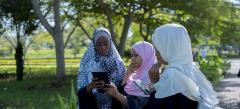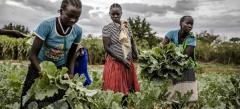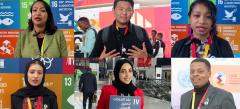- عربي
- 中文
- English
- Français
- Русский
- Español
LDC5 Q&A
Now that it has been adopted, how will the Doha Programme of Action improve the situation for people in the Least Developed Countries?
The DPoA has been adopted at an extremely critical time. While LDCs continue to face traditional challenges, there are new and emerging ones such as climate change, and even more recently, COVID-19 and its cascading impacts. The war in Ukraine has only added fuel to the fire as it drives up prices for food and fuel worldwide.
Considering all of this, the DPoA aims to recover and build back better from these crises while also building resilience against future ones. It also aims to accelerate the implementation of the 2030 Sustainable Development Agenda. Our hope is that the DPoA through increased attention and partnerships for the LDCs, will result in bringing some transformative changes.
What lessons did we learn from the pandemic about helping the LDCs prepare for future shocks?
Resilience in LDCs is poor and they struggled financially when the pandemic hit. Whereas richer had the capacity to introduce financial response packages, LDCs did not. Public health systems in the LDCs couldn’t provide sufficient equipment or facilities for the onslaught of patients. Education really suffered because not enough schools or students had access to the Internet, or a digitally compatible curriculum to move schooling online. Essentially two years of education for students in the LDCs was lost. These are major areas of focus for how we can work with the LDCs to better respond next time.
Climate Change is an issue that is created mostly in more developed countries, but it is LDCs that disproportionally suffer its consequences. What does the DPoA suggest that we can do to combat Climate Change in the LDCs?
The DPoA prioritises climate change and building resilience to future shocks. It reinforces global commitments to limiting the global temperature rise to 1.5 degrees and calls for increased funding for climate change measures in LDCs – such as implementing the commitment of spending $100 billion on climate finance annually. It promises to strike a balance between adaptation and mitigation, calling for 69% of all adaptation funds to go to LDCs and includes provisions for capacity building and technology transfer. Collectively, the commitments within the DPoA stand to benefit the LDCs benefit in terms of mitigation, adaptation and building resilience against the impacts of climate change.
What has the international community learned from the previous Programme of Action (the IPoA) and how has past experience influenced this new Doha Program of Action?
With the IPoA, the level of success did not meet the level of ambition. The main failure of the IPoA was the lack of implementation, follow up and monitoring. We simply didn’t do everything we set out to. In the DPoA, it was important for us to develop a new follow-up and monitoring mechanism to keep us on track – and accountable.
Why was LDC5 split in two, with Part 1 in New York in 2022 and Part 2 in Doha in 2023?
The previous Programme of Action for LDCs expired in 2020 and the original date for LDC5 was in March of 2021. Initially it got postponed to January of 2022 because of COVID-19 and then the omicron wave meant that it had to be postponed from that date again. But it wasn’t conscionable to leave the LDCs without a new Programme of Action for another year at such a critical time. By splitting the conference into two parts, we could fast track the adoption of the Doha Program of Action, start its implementation and address the challenges of LDCs with the support of their development partners.
Part 2 will be dedicated to making sure the goals of the DPoA are met. A comprehensive road map for the implementation of the program of action will be established and in Doha we will bring together the UN, the LDCs, development partners, the private sector, civil society, parliamentarians and youth - all do to agree partnerships, commitments, innovations and plans to make sure the goals are met. Doha will all be about building and maintaining political momentum for the DPoA at the highest possible levels.







